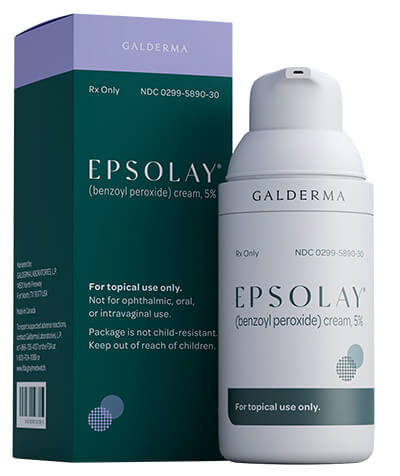The following announcement is sponsored by Galderma Laboratories, L.P.
Galderma to Commercialize FDA-Approved EPSOLAY® (Benzoyl Peroxide) Cream, 5% for the Treatment of Rosacea Bumps and Blemishes, Available by Prescription by Mid-2022
If you suffer from rosacea, you have probably had to adapt your lifestyle around it. You’re probably tired of unpredictable flares and of explaining to people that you do not have acne. Perhaps you have tried a few different treatments, with various degrees of success. You might even know the names of a few skincare agents, and whether they suit your skin or irritate it.
You are not alone. Over 16 million people in the U.S. struggle with rosacea.1 More than 82% of people feel their rosacea is uncontrolled and less than half are satisfied with their current prescription treatments.2-4
 Galderma, the world’s largest independent dermatology company, took on the challenge of bringing an innovative, science-based solution to adults struggling with rosacea bumps and blemishes.
Galderma, the world’s largest independent dermatology company, took on the challenge of bringing an innovative, science-based solution to adults struggling with rosacea bumps and blemishes.
One result of this endeavour is EPSOLAY, a topical cream containing benzoyl peroxide (BPO), 5%.5
In clinical trials, treatment with EPSOLAY Cream reduced bumps and blemishes of rosacea by nearly 70% in 12 weeks.6,7 Unlike ordinary BPO which can be irritating, EPSOLAY was designed with sensitive rosacea skin in mind.8 EPSOLAY utilizes a proprietary, patented technology that encapsulates BPO within silica-based microcapsules. These shells create a barrier between the medication and the skin and allow the slow release of BPO over time to provide a tolerable and effective treatment.8
In a long-term study, people with rosacea used EPSOLAY Cream for 52 weeks with side effects that were mild to moderate in nature.9 Nearly 50% of people with rosacea had clear or almost clear skin in 12 weeks.6,7 The most common adverse reactions (incidence <2%) in people treated with EPSOLAY Cream were pain, erythema (redness), pruritus (itching), and edema (swelling), all at the application site.5
Galderma will commercialize EPSOLAY (benzoyl peroxide) Cream, 5% in the U.S. following its approval by the U.S. Food and Drug Administration (FDA) on April 22, 2022. It will be available by prescription by mid-year 2022. Sign up for additional information at www.epsolay.com.
IMPORTANT SAFETY INFORMATION
Indication: EPSOLAY® (benzoyl peroxide) Cream, 5% is indicated for the treatment of inflammatory lesions of rosacea in adults. Adverse Events: The most common adverse reactions (incidence ≥ 1%) in patients treated with EPSOLAY were pain, erythema (redness), pruritus (itching) and edema (swelling), all at the application site. Warnings/Precautions: Patients using EPSOLAY may experience hypersensitivity reactions, including anaphylaxis (acute allergic reaction), angioedema (rapid swelling), and urticaria (hives). If serious hypersensitivity reaction occurs, discontinue use of EPSOLAY immediately and seek medical attention/initiate appropriate therapy. Skin Irritation/contact dermatitis may be experienced, including erythema (redness), scaling, dryness, and stinging/burning. Irritation and contact dermatitis may occur. Use a moisturizer and discontinue EPSOLAY if symptoms do not improve. Avoid application to cuts, abrasions, eczematous, or sunburned skin. EPSOLAY may increase photosensitivity, sensitivity to ultraviolet light. Minimize or avoid exposure to natural or artificial sunlight (tanning beds or UVA/B treatment). Use sunscreen or protective clothing when sun exposure cannot be avoided. Discontinue use of EPSOLAY at the first evidence of sunburn.
You are encouraged to report negative side effects of prescription drugs to the FDA. Visit www.fda.gov/medwatch or call 1-800-FDA-1088.
References
1. Huynh TT. Burden of disease: the psychosocial impact of rosacea on a patient’s quality of life. Am Health Drug Benefits. 2013;6:348-354.
2. Galderma Laboratories, L.P. Galderma global study reveals true burden of rosacea and encourages healthcare professionals to look ‘beyond the visible’. June 2018. Available at: https://www.galderma.com/news/galderma-global-study-reveals-true-burden-rosacea-and-encourages-healthcare-professionals-look. Accessed February 23, 2022.
3. Del Rosso JQ, Tanghetti EA, Baldwin HE, Rodriguez DA, Ferrusi IL. The burden of illness of erythematotelangiectatic rosacea and papulopustular rosacea: findings from a web-based survey. J Clin Aesthet Dermatol. 2017;10:17-31.
4. Tan J, Steinhoff M, Bewley A, Gieler U. Beyond the visible: rosacea (2018). The BMJ hosted content 2018. Available at https://hosted.bmj.com/media/images/burden-of-rosacea-beyond-the-visible.pdf. Accessed March 8, 2022.
5. Epsolay. Package insert. Galderma Laboratories, L.P.; 2022.
6. Galderma Laboratories, L.P., data on file. Clinical Study Report SGT-54-01, January 8, 2020.
7. Galderma Laboratories, L.P., data on file. Clinical Study Report SGT-54-02, March 26, 2020.
8. Bhatia N, Werschler W, Baldwin H, et al. Efficacy and safety of micro-encapsulated benzoyl peroxide (E-BPO) cream, 5% in papulopustular rosacea: results from two phase 3, vehicle-controlled trials. Poster presented at: Maui Derm for Dermatologists; January 25-29 2020, Maui, Hawaii.
8. Galderma Laboratories, L.P., data on file. Clinical Study Report SGT-54-07, March 30, 2020.